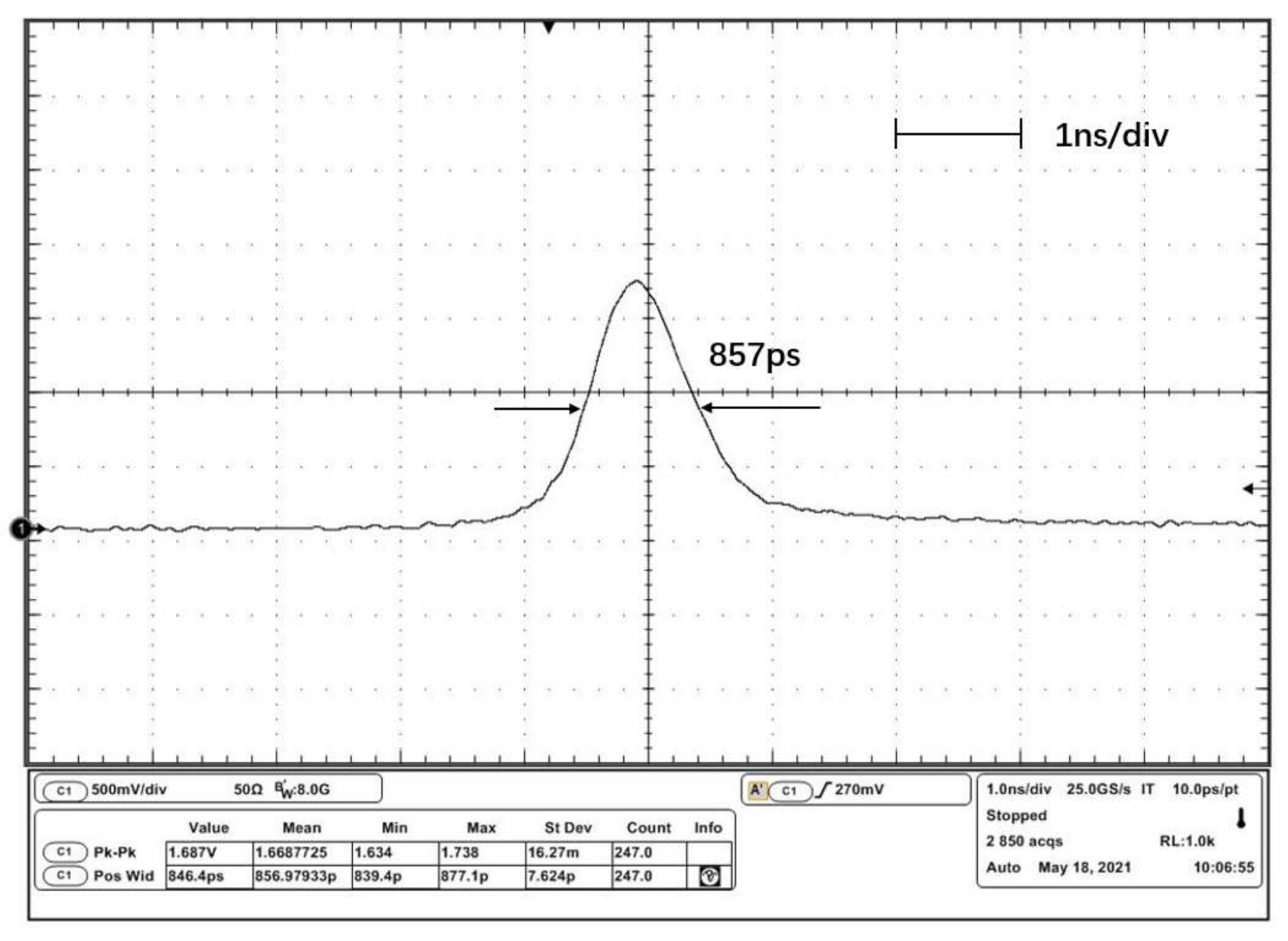High Repetition Rate, TEM00 Mode, Compact Sub-Nanosecond 532 nm Laser
Abstract
:1. Introduction
2. Experimental Setup
2.1. Sample Preparation
2.2. The Description of Experimental Setup
3. Experimental Results
3.1. Seed Source Characteristics
3.2. Two-Pass Amplification Characteristics
3.3. SHG Characteristics
4. Numerical Simulation for Sub-Nanoseconds
5. Conclusions
Author Contributions
Funding
Institutional Review Board Statement
Informed Consent Statement
Data Availability Statement
Conflicts of Interest
References
- Zayhowski, J. Topical Papers on Microchip Lasers and Applications. Passively Q-Switched Microchip Lasers and Applications. Rev. Laser Eng. 1998, 26, 841–846. [Google Scholar] [CrossRef] [Green Version]
- Zayhowski, J.J.; Terry, J.; Clarkson, W.A. Compact solid state sources and their applications. In Solid State Laser Technologies and Femtosecond Phenomena; SPIE: Cergy-Pontoise, France, 2004; Volume 5620, pp. 155–169. [Google Scholar]
- Zayhowski, J.J.; Iii, C.D.; Cook, C.; Daneu, J.L. Mid- and High-Power Passively Q-Switched Microchip Lasers. In Advanced Solid State Lasers; The Optical Society of America: Washington, DC, USA, 2001; p. 1. [Google Scholar]
- Degnan, J.J. Photon-counting multikilohertz microlaser altimeters for airborne and spaceborne topographic measurements. J. Geodyn. 2002, 34, 503–549. [Google Scholar] [CrossRef] [Green Version]
- Degnan, J.J. Unified Approach to Photon-Counting Microlaser Rangers, Transponders, and Altimeters. Surv. Geophys. 2001, 22, 431–447. [Google Scholar] [CrossRef]
- Albota, M.A.; Heinrichs, R.M.; Kocher, D.G.; Fouche, D.G.; Player, B.E.; O’Brien, M.E.; Aull, B.F.; Zayhowski, J.J.; Mooney, J.; Willard, B.C.; et al. Three-dimensional imaging laser radar with a photon-counting avalanche photodiode array and microchip laser. Appl. Opt. 2002, 41, 7671–7678. [Google Scholar] [CrossRef] [PubMed] [Green Version]
- Degnan, J.J. Rapid, Globally Contiguous, High Resolution 3D Topographic Mapping of Planetary Moons Using a Scanning, Photon-Counting Lidar. In Proceedings of the International Workshop on Instrumentation for Planetary Missions, Greenbelt, MD, USA, 1 October 2012; p. 1086. [Google Scholar]
- Degnan, J.; Machan, R.; Leventhal, E.; Jodor, G.; Field, C. Photon-Counting, 3D imaging Lidars Operating at Megapixels per Second. In Proceedings of the Conference on Lasers and Electro-Optics/International Quantum Electronics Conference, Baltimore, MD, USA, 31 May 2009; p. CFJ6. [Google Scholar]
- Degnan, J.; Wells, D.; Machan, R.; Leventhal, E. Second generation airborne 3D imaging lidars based on photon counting-art. In Proceedings-Spie the International Society for Optical Engineering; International Society for Optical Engineering: Bellingham, WA, USA, 2007; p. 67710N. [Google Scholar]
- Isyanova, Y.; Wall, K.F.; Flint, J.H.; Moulton, P.F.; Degnan, J.J. High-Power, Short-Pulse, Compact SLR2000 Laser Transmitter. In Advanced Solid-State Photonics; Optical Society of America: Washington, DC, USA, 2004; p. MB14. [Google Scholar]
- Manni, J.G. Amplification of microchip oscillator emission using a diode-pumped wedged-slab amplifier. Opt. Commun. 2005, 252, 117–126. [Google Scholar] [CrossRef]
- Pavel, N.; Saikawa, J.; Kurimura, S.; Taira, T. High Average Power Diode End-Pumped Composite Nd:YAG Laser Passively Q-switched by Cr4+:YAG Saturable Absorber. Jpn. J. Appl. Phys. 2001, 40, 1253–1259. [Google Scholar] [CrossRef]
- Pavel, N.A.; Saikawa, J.; Shoji, I.; Dascalu, T.; Lupei, V.; Taira, T. All-solid-state diode and end-pumped Nd:YAG laser passively Q-switched by Cr4+:YAG saturable absorber. SPIE Proceedings 2004, 5581, 170–180. [Google Scholar] [CrossRef]
- Bhandari, R.; Taira, T. High Repetition Rate MW Peak Power at 532 nm Using Microchip Laser. In Libros profesionales de empresaon Lasers and Electro-Optics; The Optical Society of America: Washington, DC, USA, 2013; p. JW2A.26. [Google Scholar]
- Zheng, L.; Kausas, A.; Taira, T. >30 MW peak power from distributed face cooling tiny integrated laser. Opt. Express 2019, 27, 30217–30224. [Google Scholar] [CrossRef] [PubMed]
- Miao, J.; Wang, B.; Peng, J.; Tan, H.; Bian, H. Efficient diode-pumped passively Q-switched laser with Nd: YAG/Cr: YAG composite crystal. Opt. Laser Technol. 2008, 40, 137–141. [Google Scholar] [CrossRef]
- Szabo, A.; Stein, R.A. Theory of Laser Giant Pulsing by a Saturable Absorber. J. Appl. Phys. 1965, 36, 1562–1566. [Google Scholar] [CrossRef]
- Degnan, J. Optimization of passively Q-switched lasers. IEEE J. Quantum Electron. 1995, 31, 1890–1901. [Google Scholar] [CrossRef]
- Xiao, G.; Bass, M. A generalized model for passively Q-switched lasers including excited state absorption in the saturable absorber. IEEE J. Quantum Electron. 1997, 33, 41–44. [Google Scholar] [CrossRef]









| The Pump Power of the Seed (W) | The Output Power of the Seed (mW) | Circularity of the Seed Beam | Circularity of the Amplified Beam |
|---|---|---|---|
| 2.4 | 37.8 | 0.876 | 0.661 |
| 3.3 | 206.4 | 0829 | 0.747 |
| 3.9 | 317.8 | 0.779 | 0.927 |
| Cavity Length, CL (mm) | Reflectivity of Output Coupler, R% | Pulse Width (ns) |
|---|---|---|
| 7 | 35 | 0.909 |
| 40 | 0.851 | |
| 45 | 0.809 | |
| 9 | 35 | 1.169 |
| 40 | 1.095 | |
| 45 | 1.041 |
Publisher’s Note: MDPI stays neutral with regard to jurisdictional claims in published maps and institutional affiliations. |
© 2022 by the authors. Licensee MDPI, Basel, Switzerland. This article is an open access article distributed under the terms and conditions of the Creative Commons Attribution (CC BY) license (https://creativecommons.org/licenses/by/4.0/).
Share and Cite
Meng, D.; Wang, T.; Zhou, M.; Qiao, Z.; Liu, X.; Fan, Z. High Repetition Rate, TEM00 Mode, Compact Sub-Nanosecond 532 nm Laser. Appl. Sci. 2022, 12, 4428. https://doi.org/10.3390/app12094428
Meng D, Wang T, Zhou M, Qiao Z, Liu X, Fan Z. High Repetition Rate, TEM00 Mode, Compact Sub-Nanosecond 532 nm Laser. Applied Sciences. 2022; 12(9):4428. https://doi.org/10.3390/app12094428
Chicago/Turabian StyleMeng, Dongdong, Tianqi Wang, Mi Zhou, Zhanduo Qiao, Xiaolong Liu, and Zhongwei Fan. 2022. "High Repetition Rate, TEM00 Mode, Compact Sub-Nanosecond 532 nm Laser" Applied Sciences 12, no. 9: 4428. https://doi.org/10.3390/app12094428
APA StyleMeng, D., Wang, T., Zhou, M., Qiao, Z., Liu, X., & Fan, Z. (2022). High Repetition Rate, TEM00 Mode, Compact Sub-Nanosecond 532 nm Laser. Applied Sciences, 12(9), 4428. https://doi.org/10.3390/app12094428





